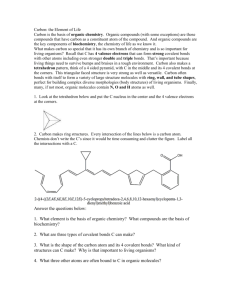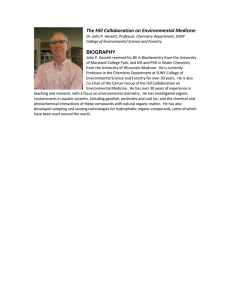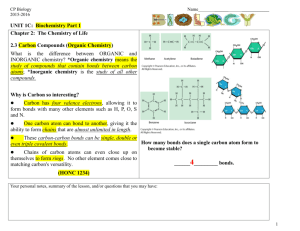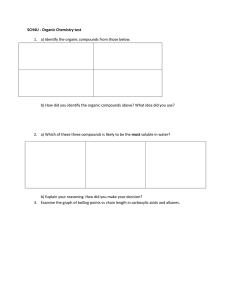What is an organic compound?
advertisement
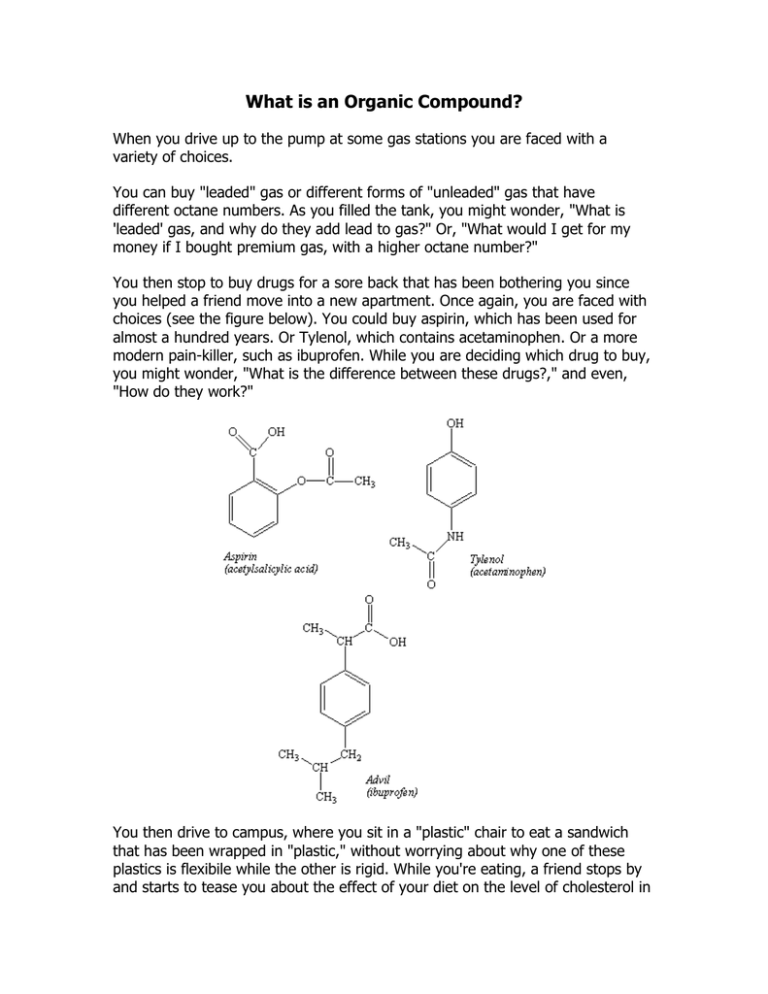
What is an Organic Compound? When you drive up to the pump at some gas stations you are faced with a variety of choices. You can buy "leaded" gas or different forms of "unleaded" gas that have different octane numbers. As you filled the tank, you might wonder, "What is 'leaded' gas, and why do they add lead to gas?" Or, "What would I get for my money if I bought premium gas, with a higher octane number?" You then stop to buy drugs for a sore back that has been bothering you since you helped a friend move into a new apartment. Once again, you are faced with choices (see the figure below). You could buy aspirin, which has been used for almost a hundred years. Or Tylenol, which contains acetaminophen. Or a more modern pain-killer, such as ibuprofen. While you are deciding which drug to buy, you might wonder, "What is the difference between these drugs?," and even, "How do they work?" You then drive to campus, where you sit in a "plastic" chair to eat a sandwich that has been wrapped in "plastic," without worrying about why one of these plastics is flexibile while the other is rigid. While you're eating, a friend stops by and starts to tease you about the effect of your diet on the level of cholesterol in your blood, which brings up the questions, "What is cholesterol?" and "Why do so many people worry about it?" Answers to each of these questions fall within the realm of a field known as organic chemistry. For more than 200 years, chemists have divided materials into two categories. Those isolated from plants and animals were classified as organic, while those that trace back to minerals were inorganic. At one time, chemists believed that organic compounds were fundamentally different from those that were inorganic because organic compounds contained a vital force that was only found in living systems. The first step in the decline of the vital force theory occurred in 1828, when Friederich Wohler synthesized urea from inorganic starting materials. Wohler was trying to make ammonium cyanate (NH4OCN) from silver cyanate (AgOCN) and ammonium chloride (NH4Cl). What he expected is described by the following equation. AgOCN(aq) + NH4Cl(aq) AgCl(s) + NH4OCN(aq) The product he isolated from this reaction had none of the properties of cyanate compounds. It was a white, crystalline material that was identical to urea, H2NCONH2, which could be isolated from urine. Neither Wohler nor his contemporaries claimed that his results disproved the vital force theory. But his results set in motion a series of experiments that led to the synthesis of a variety of organic compounds from inorganic starting materials. This inevitably led to the disappearance of "vital force" from the list of theories that had any relevance to chemistry, although it did not lead to the death of the theory, which still had proponents more than 90 years later. If the difference between organic and inorganic compounds isn't the presence of some mysterious vital force required for their synthesis, what is the basis for distinguishing between these classes of compounds? Most compounds extracted from living organisms contain carbon. It is therefore tempting to identify organic chemistry as the chemistry of carbon. But this definition would include compounds such as calcium carbonate (CaCO3), as well as the elemental forms of carbon diamond and graphite that are clearly inorganic. We will therefore define organic chemistry as the chemistry of compounds that contain both carbon and hydrogen. Even though organic chemistry focuses on compounds that contain carbon and hydrogen, more than 95% of the compounds that have isolated from natural sources or synthesized in the laboratory are organic. The special role of carbon in the chemistry of the elements is the result of a combination of factors, including the number of valence electrons on a neutral carbon atom, the electronegativity of carbon, and the atomic radius of carbon atoms (see the table below). The Physical Properties of Carbon Electronic configuration 1s2 2s2 2p2 Electronegativity 2.55 Covalent radius 0.077 nm Carbon has four valence electrons 2s2 2p2 and it must either gain four electrons or lose four electrons to reach a rare-gas configuration. The electronegativity of carbon is too small for carbon to gain electrons from most elements to form C4- ions, and too large for carbon to lose electrons to form C4+ ions. Carbon therefore forms covalent bonds with a large number of other elements, including the hydrogen, nitrogen, oxygen, phosphorus, and sulfur found in living systems. Because they are relatively small, carbon atoms can come close enough together to form strong C=C double bonds or even C C triple bonds. Carbon also forms strong double and triple bonds to nitrogen and oxygen. It can even form double bonds to elements such as phosphorus or sulfur that do not form double bonds to themselves. Several years ago, the unmanned Viking spacecraft carried out experiments designed to search for evidence of life on Mars. These experiments were based on the assumption that living systems contain carbon, and the absence of any evidence for carbon-based life on that planet was presumed to mean that no life existed. Several factors make carbon essential to life. The ease with which carbon atoms form bonds to other carbon atoms. The strength of C C single bonds and the covalent bonds carbon forms to other nonmetals, such as N, O, P, and S. The ability of carbon to form multiple bonds to other nonmetals, including C, N, O, P, and S atoms. These factors provide an almost infinite variety of potential structures for organic compounds, such as vitamin C shown in the figure below. No other element can provide the variety of combinations and permutations necessary for life to exist.

